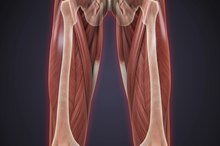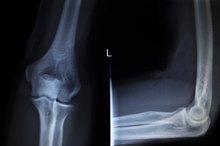Gluteus Medius Muscle Strain
The gluteus medius muscle is essential to many common daily movements, and you probably won't even think about it until it gets hurt. Because of it's central location and position, the gluteus medius risks injury from overuse, trauma, or even the compensation for pain in other areas. Although a strain can be painful, conservative treatment is usually all that is needed. A regular stretching and strengthening routine can prevent future re-injury.
About the Muscle
The gluteus medius runs from the top of the pelvis to the head of the thighbone on either side. The main hip abductor, it is responsible for moving laterally, such as stepping out of the bath tub. It also rotates the outward, and is one of the main stabilizing muscles that keep your legs pointing forward when you walk. In fact, people with underdeveloped or degenerated gluteus medius muscles often develop an unnatural gait.
- The gluteus medius runs from the top of the pelvis to the head of the thighbone on either side.
- The main hip abductor, it is responsible for moving laterally, such as stepping out of the bath tub.
Risk of Injury
Sartorius & Gracilis Injuries
Learn More
Because the muscle is so important to virtually every lower-body activity, the risk of injury is great. Runners are especially prone, but any athlete involved in high-impact sports or abrupt lateral movement such as soccer or basketball can easily injure a weak gluteus medius. Adjusting your gait or posture to compensate for back pain can also negatively affect the muscle. Overuse injuries are the most common, resulting from a failure to properly stretch and strengthen the muscle, but trauma, such as a fall, can also contribute to injury.
- Because the muscle is so important to virtually every lower-body activity, the risk of injury is great.
- Overuse injuries are the most common, resulting from a failure to properly stretch and strengthen the muscle, but trauma, such as a fall, can also contribute to injury.
Treatment
Most gluteus medius injuries are strains, which is a Grade 1 injury -- rest, ice and an over-the-counter anti-inflammatory pain reliever are all that is necessary. Grade 2 injuries involve a partial tear of the muscle, which utilizes the same treatment, only for an extended period. A complete muscle tear is considered Grade 3, and may require surgery. According to Medical Disability Guidelines, 70 percent of patients who have had surgery report having a "normal-feeling" hip within two years, with the remaining 30 percent feeling nearly normal. Performing prevention exercises can also help to regain muscle strength after a period of rest and recovery.
- Most gluteus medius injuries are strains, which is a Grade 1 injury -- rest, ice and an over-the-counter anti-inflammatory pain reliever are all that is necessary.
- According to Medical Disability Guidelines, 70 percent of patients who have had surgery report having a "normal-feeling" hip within two years, with the remaining 30 percent feeling nearly normal.
Prevention
Iliopsoas Tendon Pain When Walking
Learn More
Gentle abduction exercises such as leg lifts with a resistance band can help strengthen the muscle. Perform them both standing and lying on your side to work the muscle from different angles. Lying on your back and crossing the affected leg over your body will stretch the area, as will lying on your stomach, bending your knee and moving your foot toward the back of your head. These exercises should be done gradually and cautiously after an injury, but can also be used consistently to prevent one. If you feel pain, back off -- you should feel only a slight tension in the stretch.
- Gentle abduction exercises such as leg lifts with a resistance band can help strengthen the muscle.
- Lying on your back and crossing the affected leg over your body will stretch the area, as will lying on your stomach, bending your knee and moving your foot toward the back of your head.
Related Articles
References
- MDGuidelines: Gluteus Medius Tear
- Dynamic Chiropractic: Ilio-Sacral Diagnosis and Treatment, Part Three: Gluteus Medius, Piriformis and Pubic Symphysis - Positional Release and Rehabilitation Exercises
- SportsInjuryClinic.net: Gluteus Medius
- The Pain Clinic: Joint Pain - Hip
- Sources:
- Moore, Keith, L. and Dalley, Arthur, F. Clinically Oriented Anatomy. 5th Edition. Lippincott, Williams and Wilkins, A Wolters Klower Company.
- Tortera, Gerard J. Principles of Human Anatomy. 6th Edition. Biological Sciences Textbooks, Inc. New York. 1996. Baltimore. 2006.
Writer Bio
Angela Brady has been writing since 1997. Currently transitioning to a research career in oncolytic virology, she has won awards for her work related to genomics, proteomics, and biotechnology. She is also an authority on sustainable design, having studied, practiced and written extensively on the subject.









